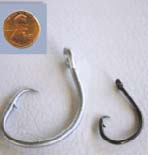This new ruling became effective on June 1 2008 and was implemented to end over-fishing in the Gulf's red snapper fishery and reduce release mortality in reef fish. Florida also approved these measures to maintain consistency with the federal management plan.
In addition to other rules which will reduce the red snapper allowable catch both commercial fishers and recreational anglers targeting reef fish species, which includes all snappers, groupers, sea bass, amberjacks, gray triggerfish, hogfish, red porgy and golden tilefish in the Gulf of Mexico and Florida state waters to adhere to the new rulings.
The new rules require all commercial fishers and recreational anglers to have and use venting tools, de-hooking devices and non-stainless circle hooks when using natural baits either alive or dead.
Venting Tools It's unlikely you will catch fish requiring the use of a vent tool while inshore fishing. However the amendment states you must have a vent tool when fishing for Federal and State waters for any reef species. However, fish caught at depths over 50 feet and quickly brought to the surface by hook and line normally suffer from gas expansion in their swim bladder. This rapid pressure expansion is often enough to push the fish's stomach out of its mouth. This pressure exerts considerable stress on internal organs resulting in serious injuries, if not quickly deflated. Fish released in this inflated condition it cannot return to comfortable depths and often floats away, consumed by other predators or dying from exposure.
All venting tools must be designed to inflict minimal damage to the fish, while allowing trapped gases to be released from the expanded swim bladder. This device must be a sharpened hollow instrument like a 16 gauge needle/hypodermic syringe w/plunger removed or 16 gauge needle fixed to a wooden handle. When venting the tool should be inserted 1 to 2 inches behind the pectoral fin at a 45 degree angle. It should only be inserted deep enough to help deflate the fish.
Anglers are using various devices including hypodermic needles. Angler and general public safety should be the number one concern when purchasing, using and discarding these devices. I recently found a company located in Tampa, Florida, named Team Marine USA. In my opinion they have taken venting and de-hooking to a new level with angler safety and fish welfare their foremost concern. They produce the safest and fish friendliest tool manufactured anywhere and it comes with a "lifetime warranty".
Hypodermic syringes w/o plungers, non-locking needle devices, and needles in a wooden dowel in my estimation are not angler safe and the most dangerous to use. Why?
- For starters hypodermic syringes where never designed for multiple use to prevent serious injury and infections. They are also bio-hazard devices and must be properly disposed at bio-hazard facilities never put in the trash or thrown overboard to wash ashore.
- Ever thy putting the needle cover back on in pitching or rolling sea you will probably get stuck?
- The flimsy covers never stay on when stored in your tackle bag. The last thing you need is dirty needle with water born bacteria sticking out.
- If you ever get stopped by Homeland Security, U.S. Coast Guard or local law enforcement and they find a syringe onboard. It will probably take some convincing to explain why you have drug paraphernalia in your possession.
De-hooking Tools De-hooking devices or de-hookers are designed to safely remove a hook without it re-engaging the fish. They also prevent removal of the fish's protective slime usually disturbed when handling fish during release. You can find in stores selling fishing supplies or you can also find them online at TeamMarineUSA.com. They must be blunted with rounded edges, and suitable for the size hook you are removing. Here are a few tips on how to use a de-hooker:
- Use common sense, if you cannot see the hook its best left in the fish. Simply leave the fish in the water and cut the line as close to the hook as possible.
- In most instances, especially with circle hooks, the hook is in the outer edges of the fish's mouth. Grab the leader and place it into the up-ward facing "U" of the de-hooker and slide it into the hooks throat. Now holding the leader taught and below the fish, lift on the hook with a quick snap and the fish is released without touching it.
Non-Stainless Circle Hooks Although inshore snapper seldom reach the size of offshore varieties you must still adhere to this particular change while in inshore waters, like Tampa Bay. The new amendment prohibits using anything other than circle hooks when using any form of natural bait. The only difference between Federal and Florida state waters is the type of circle hook. In Federal waters, beyond nine miles, any form of non-stainless circle hook is permitted. However, within Florida's waters all non-stainless circle hooks must be classified as in-line and not off-set.
Circle hooks are designed so that the point is turned at right angles to the shank forming a circular shape. The main advantage is that fish are seldom deep-hooked and studies show that circle hooks normally hook in the outer parts of the mouth rather than the throat or gut. And by not using stainless steel, the hook usually deteriorates over time. However, studies also suggest that a deeply hooked fish's survival rate increases if you simply cut the line as close as possible leaving the hook.
Capt. Woody Gore Charters
www.captainwoodygore.com
wgore@ix.netcom.com
813-477-3814




